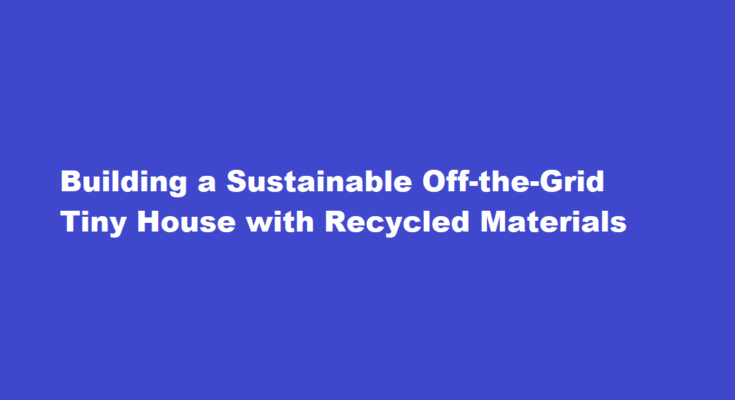Introduction
In today’s fast-paced world, the pursuit of sustainability has become crucial to preserving the environment for future generations. A sustainable, off-the-grid tiny house made from recycled materials is an excellent example of how we can reduce our carbon footprint while embracing a simpler, more mindful way of living. In this article, we will explore the steps and considerations involved in constructing a unique, eco-friendly tiny home that blends environmental consciousness with modern comfort and functionality.
Planning and Designing
The first step in building a sustainable tiny house is to carefully plan and design the layout. Utilize computer software or sketch on paper to optimize the available space and incorporate energy-efficient features. Maximize natural light and ventilation to reduce reliance on artificial lighting and cooling systems. Embrace a minimalist mindset and prioritize multi-purpose furniture to make the most of every square foot.
Sourcing Recycled Materials
To create a sustainable tiny house, the choice of materials plays a crucial role. Sourcing recycled materials is essential in reducing the demand for new resources and minimizing waste. Look for local salvage yards, building material exchanges, and online marketplaces that specialize in reclaimed items. Materials like reclaimed wood, salvaged windows, and repurposed metal can add character and authenticity to your tiny house while promoting sustainability.
Insulation and Energy Efficiency
Proper insulation is key to maintaining a comfortable indoor temperature without excessive reliance on heating or cooling systems. Utilize eco-friendly insulation materials such as recycled denim, cellulose, or sheep’s wool. Additionally, invest in energy-efficient appliances and lighting fixtures to minimize electricity consumption.
Rainwater Harvesting
Water is a precious resource, especially in off-the-grid living. Set up a rainwater harvesting system to collect and store rainwater for everyday use. Install gutters and a storage tank to capture and filter rainwater, making it suitable for cooking, cleaning, and even showering. This approach reduces the strain on local water supplies and helps you live more sustainably.
Solar Power
Harnessing solar power is a game-changer for off-the-grid tiny homes. Solar panels can generate electricity to power essential appliances and lighting. Additionally, solar water heaters can provide hot water for daily needs, further reducing reliance on traditional power sources. While the initial investment may seem high, the long-term savings and reduced environmental impact make it a worthwhile investment.
Composting Toilets
Conventional flushing toilets consume significant amounts of water and require complex waste management systems. A more sustainable option is a composting toilet, which uses natural processes to break down waste into compost. These toilets are odorless, water-saving, and provide nutrient-rich compost that can be used for gardening, closing the loop on waste management.
Green Roof and Vertical Gardening
Incorporate green roofing and vertical gardening into your tiny house design. A green roof helps insulate the house, absorbs rainwater, and provides a habitat for local wildlife. Additionally, growing your own vegetables and herbs using vertical gardening techniques allows you to be more self-sufficient and reduce your reliance on store-bought produce.
Greywater Recycling
Implement a greywater recycling system to treat and reuse water from sinks and showers. After simple filtration, this water can be used for non-potable purposes like watering plants and flushing toilets. By reusing greywater, you can significantly reduce overall water consumption and support a more sustainable lifestyle.
FREQUENTLY ASKED QUESTIONS
Can you make a building out of recycled materials?
In some cases, recycled materials can make structures stronger, more efficient and less expensive to build than new materials. Charitable foundations have used plastic two-liter soda bottles to build shelters, schools and other buildings in impoverished areas.
What are the environmental benefits of living in a tiny house?
Less space equals fewer possessions, a decrease in consumables means less packaging and less waste. As your consumption drops, so does your environmental impact. And, just as your tiny home has less space inside, it also takes up less space outside, which means it has a smaller ecological footprint.
Conclusion
Building a sustainable, off-the-grid tiny house with recycled materials is a fulfilling and eco-conscious endeavor. By integrating renewable energy sources, green building techniques, and reclaimed materials, you can create a unique space that reflects your values while minimizing your impact on the environment. Remember to plan diligently, prioritize energy efficiency, and utilize recycled materials wherever possible. Embrace the journey of constructing a tiny house that aligns with your commitment to sustainability and inspires others to join the movement towards a greener, more sustainable future.
Read Also : Unleashing Creativity How to Craft an Interactive Art Installation using Augmented Reality



